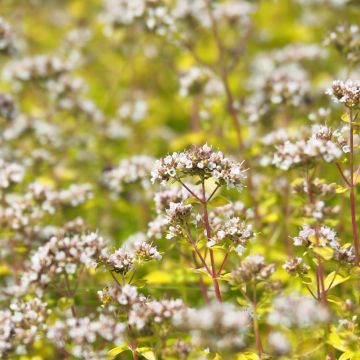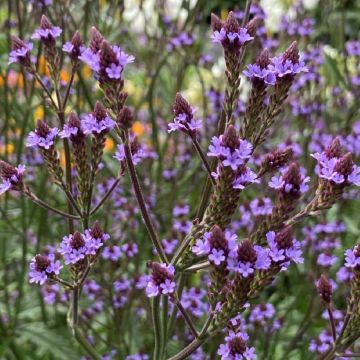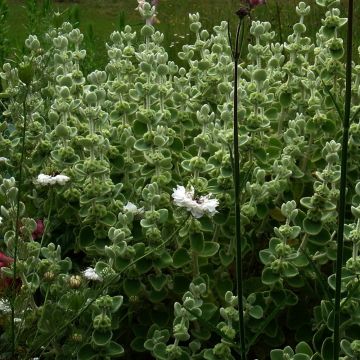

Thymus praecox Albiflorus - Thyme
Thymus praecox Albiflorus - Thyme
Thymus praecox Albiflorus
Wild Thyme, Creeping Thyme
Plant ordered several times and I have always been very satisfied.
Maylis, 24/10/2024
This item cannot be shipped to the selected country
Delivery charge from €5.90
Delivery charge from €5.90
More information
Schedule delivery date,
and select date in basket
This plant carries a 12 months recovery warranty
More information
We guarantee the quality of our plants for a full growing cycle, and will replace at our expense any plant that fails to recover under normal climatic and planting conditions.
From €5.90 for pickup delivery and €6.90 for home delivery
Express home delivery from €8.90.
From €5.90 for pickup delivery and €6.90 for home delivery
Express home delivery from €8.90.

Does this plant fit my garden?
Set up your Plantfit profile →
Description
Thymus praecox 'Albiflorus', also known as early thyme or creeping thyme, is an excellent perennial ground cover for dry to arid areas with an abundant pure white summer flowering. The plant forms a low and compact carpet composed of pleasantly scented light green evergreen foliage. It disappears in summer under a myriad of small white flowers. It is ideal for rock gardens or in the gaps between paving stones and walls. It grows slowly. It is not afraid of drought or cold, and thrives in well-drained and poor soil.
Native to Western Europe, early thyme belongs to the Lamiaceae family. In the wild, it is found in dry and arid areas, especially in limestone and sandy soils. The 'Albiflorus' variety is the white-flowered form of this medicinal and aromatic plant. This variety has a carpeting habit and forms a dense foliage mat, 2 to 5cm (1 to 2in) high and 30 to 40cm (12 to 16in) wide. Its tiny foliage is oval, leathery, and hairy. It covers flexible, prostrate and root-producing stems at the nodes, so that the plant spreads laterally over time. Numerous essential oil glands are visible under a magnifying glass on the leaves. Its scent is slightly less pronounced than that of common thyme, but more refined and balsamic. Flowering takes place from June to July-August depending on the climate. Very small white flowers, grouped in dense whorls, bloom in spherical cymes at the ends of the current year's shoots, attracting many pollinating insects. Like many Mediterranean plants adapted to drought, thymes develop a double root system, composed of a central taproot, which sinks deeply into the ground or into cracks in rocks, and a superficial network of very long rootlets capable of capturing the slightest surface moisture.
Thymus praecox 'Albiflorus' is decorative all year round. It proves to be very hardy when planted in perfectly drained or even arid soil. Its carpeting habit makes it an ideal plant for elegantly filling in the gaps between paving stones, cracks, and tops of walls, or the edges of a stone staircase, especially as it tolerates moderate foot traffic well. It can cover the ground in a dry plant bed with lavender, rockroses, shrubby salvias, dwarf wormwoods, cotton lavenders or rosemary. It will thrive in a very sunny rock garden, keeping company with Aubrieta canescens, and golden or silver baskets.
It is also used as a condiment. Its fragrance is highly appreciated in cooking. Used alone or in a bouquet garni, combined with bay leaves, parsley and rosemary, thyme leaves flavour stews, sauces, and marinades. They are also used in infusions, reputed to relieve digestive ailments. A sun-loving plant, thyme can also be planted in a dry border or in a pot, which allows it to be kept close to the kitchen.
Report an error about the product description
Thymus praecox Albiflorus - Thyme in pictures




Flowering
Foliage
Plant habit
Botanical data
Thymus
praecox
Albiflorus
Lamiaceae
Wild Thyme, Creeping Thyme
Mediterranean
Other Herb perennials
Planting and care
It requires perfectly drained soil, preferably sandy or poor, or even limestone and rocky, to withstand the harshness of winter. It is not very demanding but dreads very humid and cold winters in heavy soil. Plant it after the last frost in cold climates, and in September-October in hot and dry climates. It cannot thrive without sunlight and likes to have warm roots. When planted in overly rich soil, it becomes sad and lacks fragrance. Plant it in a raised bed enriched with gravel, in a rock garden, in full sun against a south-facing wall, or on a rocky or sandy embankment. Plant in any substrate that does not retain moisture, which would be fatal to it in winter. Prune the stems after flowering to maintain a compact habit. It may be necessary to replant it every 3 years, as the centre of the plant tends to thin out, especially in fertile soil.
Thymes can resist grazing by sheep and goats. It does not endanger their lives at all, but rather allows them to age better.
Planting period
Intended location
Care
-
, onOrder confirmed
Reply from on Promesse de fleurs
Summer flowering perennials
Haven't found what you were looking for?
Hardiness is the lowest winter temperature a plant can endure without suffering serious damage or even dying. However, hardiness is affected by location (a sheltered area, such as a patio), protection (winter cover) and soil type (hardiness is improved by well-drained soil).

Photo Sharing Terms & Conditions
In order to encourage gardeners to interact and share their experiences, Promesse de fleurs offers various media enabling content to be uploaded onto its Site - in particular via the ‘Photo sharing’ module.
The User agrees to refrain from:
- Posting any content that is illegal, prejudicial, insulting, racist, inciteful to hatred, revisionist, contrary to public decency, that infringes on privacy or on the privacy rights of third parties, in particular the publicity rights of persons and goods, intellectual property rights, or the right to privacy.
- Submitting content on behalf of a third party;
- Impersonate the identity of a third party and/or publish any personal information about a third party;
In general, the User undertakes to refrain from any unethical behaviour.
All Content (in particular text, comments, files, images, photos, videos, creative works, etc.), which may be subject to property or intellectual property rights, image or other private rights, shall remain the property of the User, subject to the limited rights granted by the terms of the licence granted by Promesse de fleurs as stated below. Users are at liberty to publish or not to publish such Content on the Site, notably via the ‘Photo Sharing’ facility, and accept that this Content shall be made public and freely accessible, notably on the Internet.
Users further acknowledge, undertake to have ,and guarantee that they hold all necessary rights and permissions to publish such material on the Site, in particular with regard to the legislation in force pertaining to any privacy, property, intellectual property, image, or contractual rights, or rights of any other nature. By publishing such Content on the Site, Users acknowledge accepting full liability as publishers of the Content within the meaning of the law, and grant Promesse de fleurs, free of charge, an inclusive, worldwide licence for the said Content for the entire duration of its publication, including all reproduction, representation, up/downloading, displaying, performing, transmission, and storage rights.
Users also grant permission for their name to be linked to the Content and accept that this link may not always be made available.
By engaging in posting material, Users consent to their Content becoming automatically accessible on the Internet, in particular on other sites and/or blogs and/or web pages of the Promesse de fleurs site, including in particular social pages and the Promesse de fleurs catalogue.
Users may secure the removal of entrusted content free of charge by issuing a simple request via our contact form.
The flowering period indicated on our website applies to countries and regions located in USDA zone 8 (France, the United Kingdom, Ireland, the Netherlands, etc.)
It will vary according to where you live:
- In zones 9 to 10 (Italy, Spain, Greece, etc.), flowering will occur about 2 to 4 weeks earlier.
- In zones 6 to 7 (Germany, Poland, Slovenia, and lower mountainous regions), flowering will be delayed by 2 to 3 weeks.
- In zone 5 (Central Europe, Scandinavia), blooming will be delayed by 3 to 5 weeks.
In temperate climates, pruning of spring-flowering shrubs (forsythia, spireas, etc.) should be done just after flowering.
Pruning of summer-flowering shrubs (Indian Lilac, Perovskia, etc.) can be done in winter or spring.
In cold regions as well as with frost-sensitive plants, avoid pruning too early when severe frosts may still occur.
The planting period indicated on our website applies to countries and regions located in USDA zone 8 (France, United Kingdom, Ireland, Netherlands).
It will vary according to where you live:
- In Mediterranean zones (Marseille, Madrid, Milan, etc.), autumn and winter are the best planting periods.
- In continental zones (Strasbourg, Munich, Vienna, etc.), delay planting by 2 to 3 weeks in spring and bring it forward by 2 to 4 weeks in autumn.
- In mountainous regions (the Alps, Pyrenees, Carpathians, etc.), it is best to plant in late spring (May-June) or late summer (August-September).
The harvesting period indicated on our website applies to countries and regions in USDA zone 8 (France, England, Ireland, the Netherlands).
In colder areas (Scandinavia, Poland, Austria...) fruit and vegetable harvests are likely to be delayed by 3-4 weeks.
In warmer areas (Italy, Spain, Greece, etc.), harvesting will probably take place earlier, depending on weather conditions.
The sowing periods indicated on our website apply to countries and regions within USDA Zone 8 (France, UK, Ireland, Netherlands).
In colder areas (Scandinavia, Poland, Austria...), delay any outdoor sowing by 3-4 weeks, or sow under glass.
In warmer climes (Italy, Spain, Greece, etc.), bring outdoor sowing forward by a few weeks.
























































